
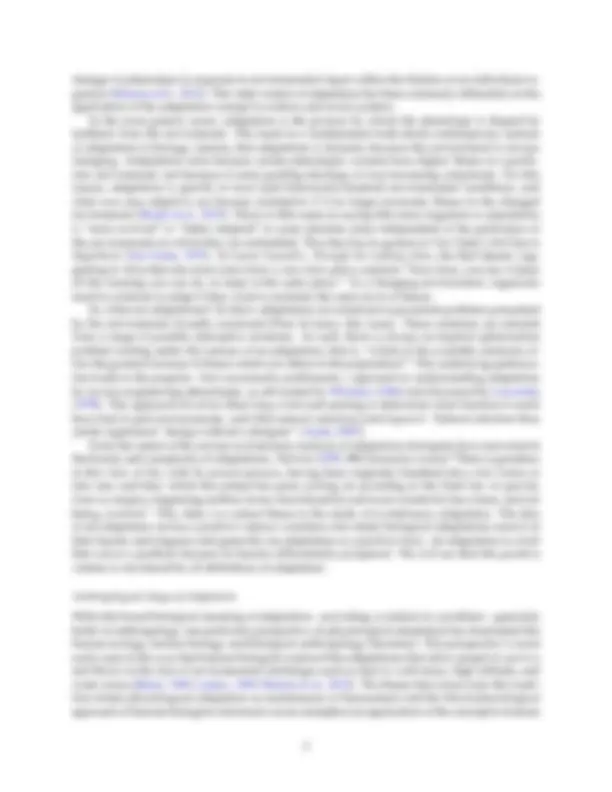
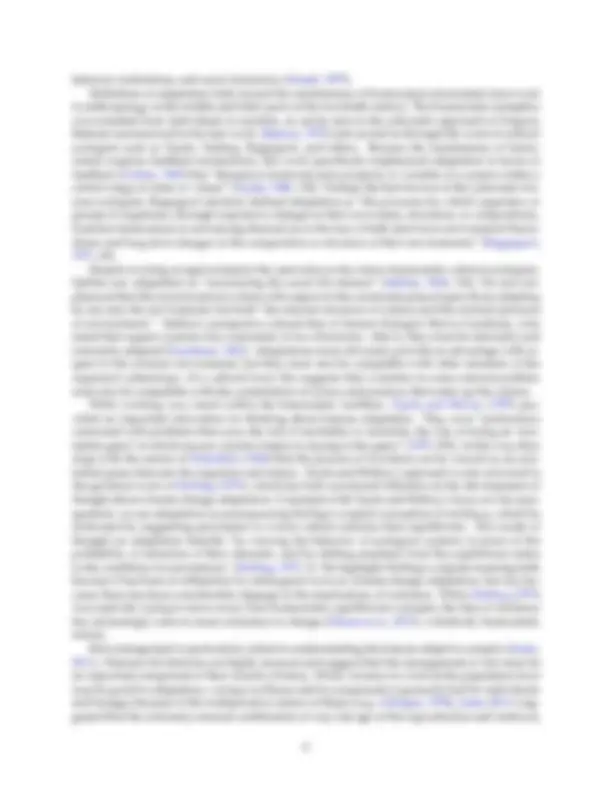
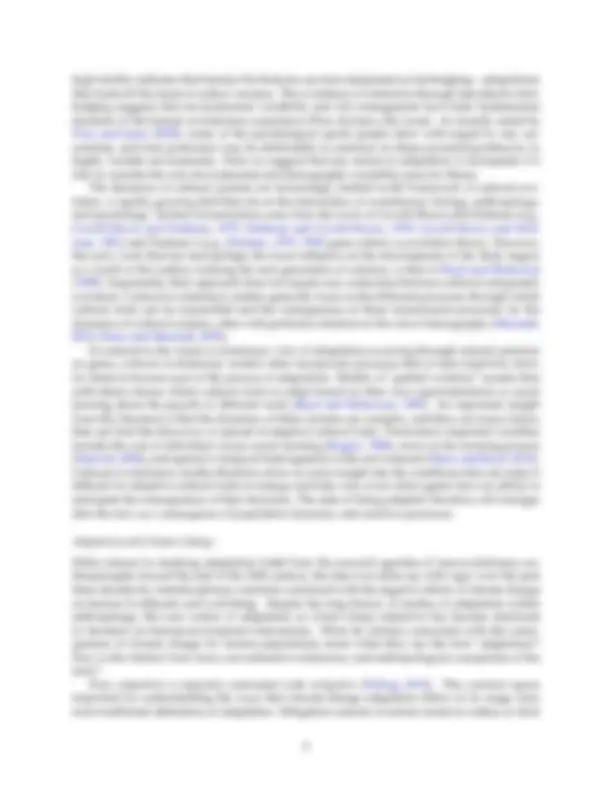
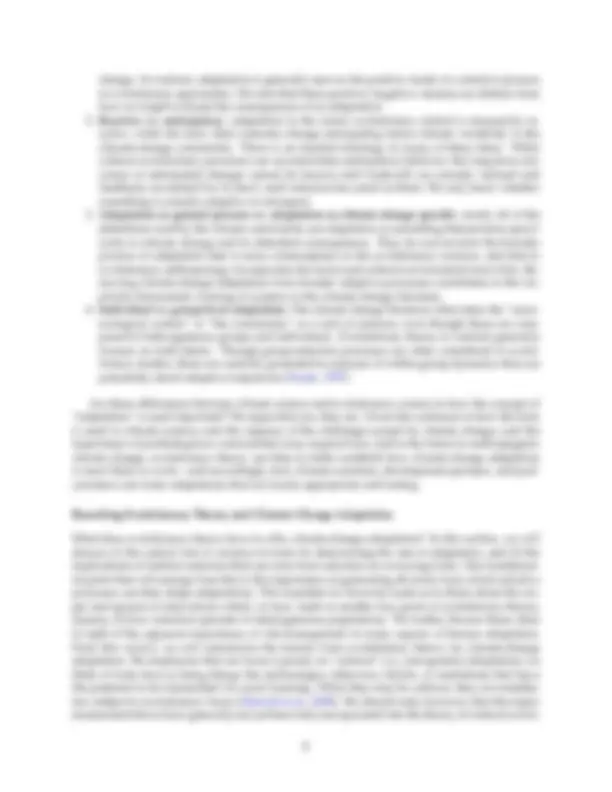
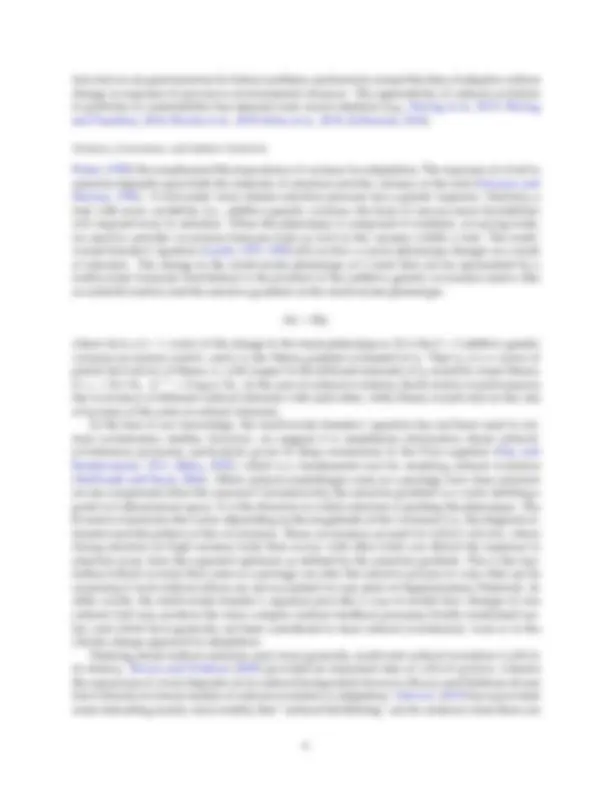
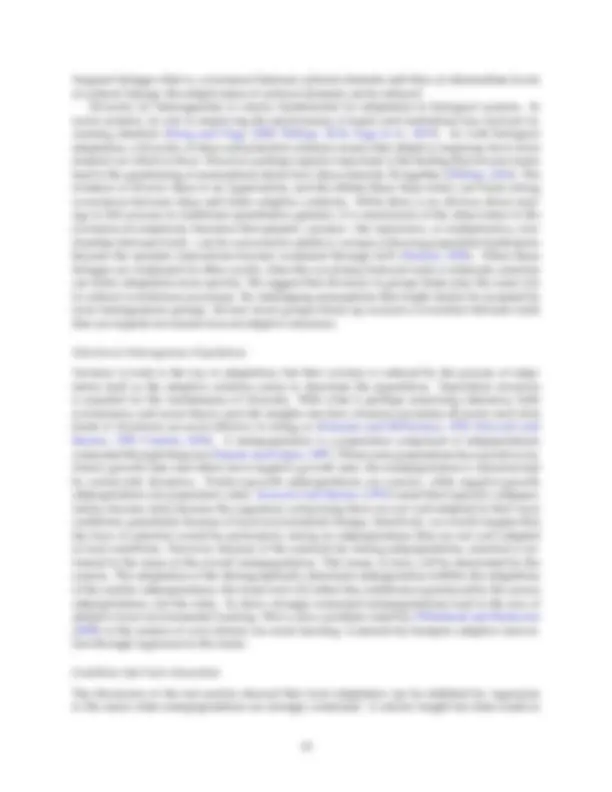
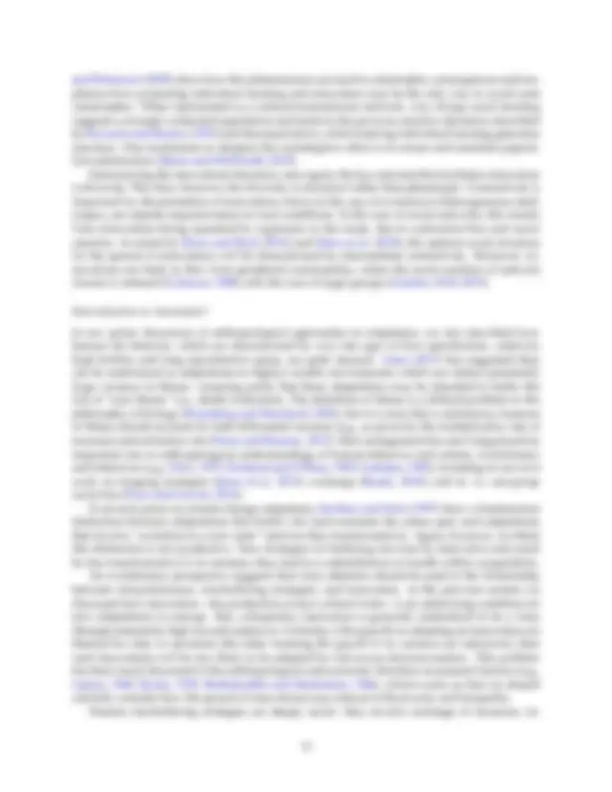
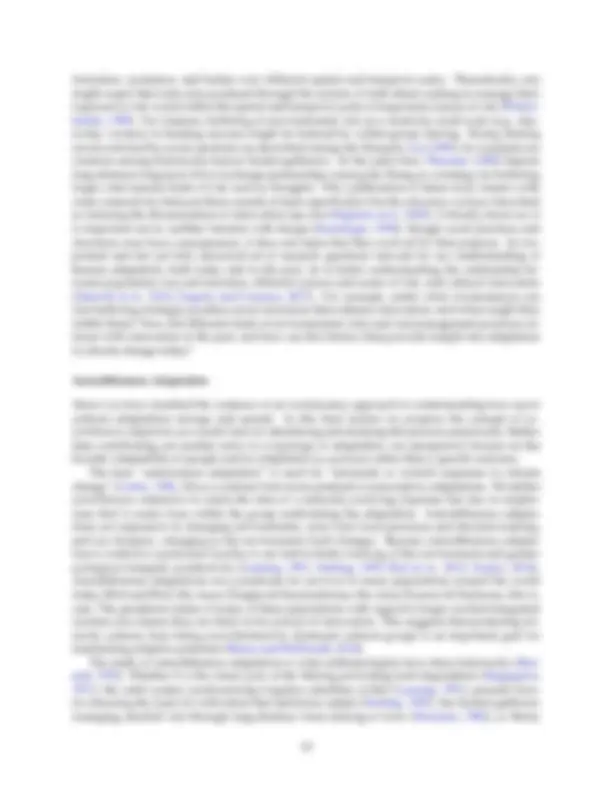
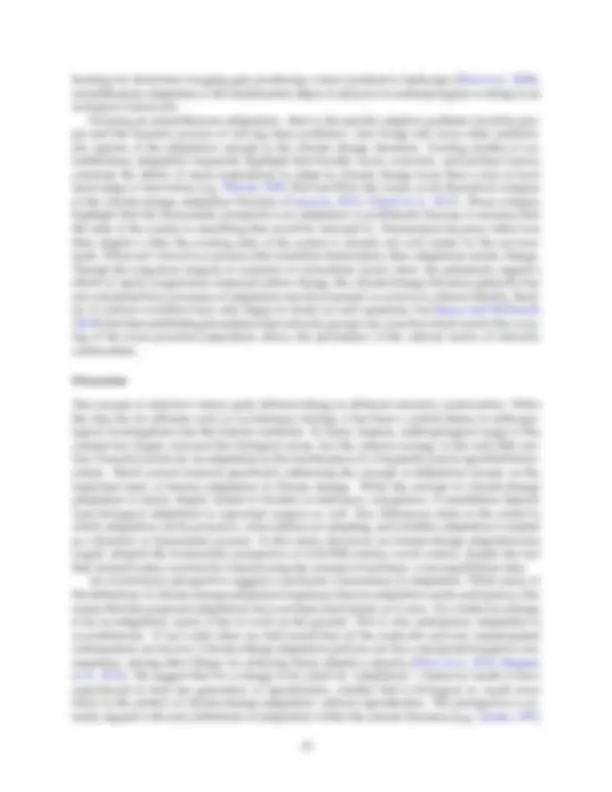
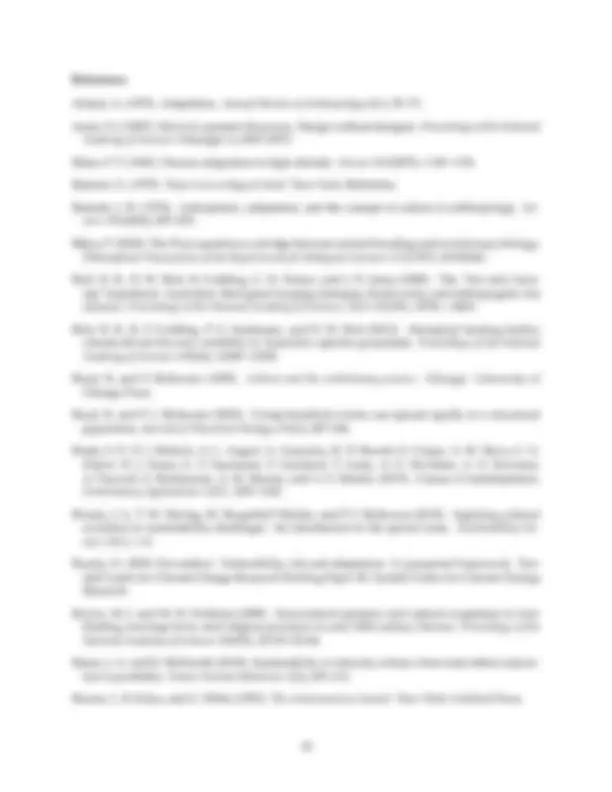
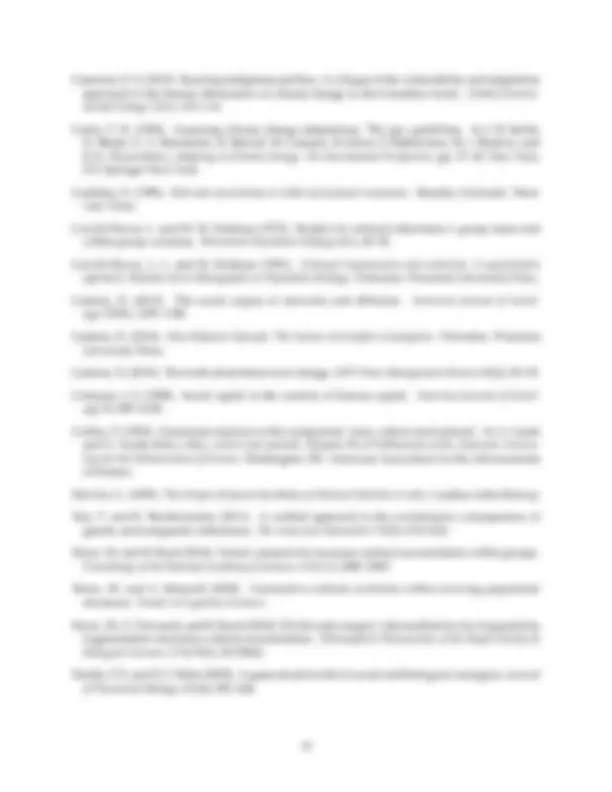
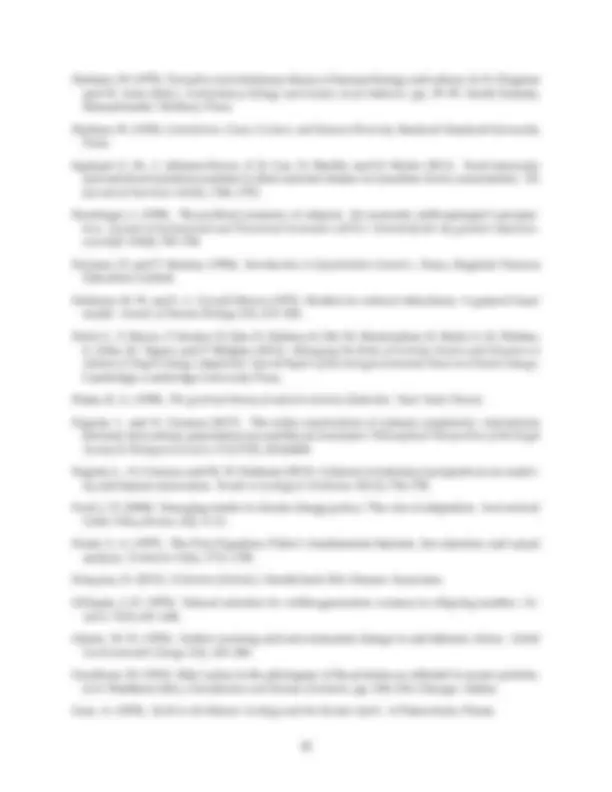
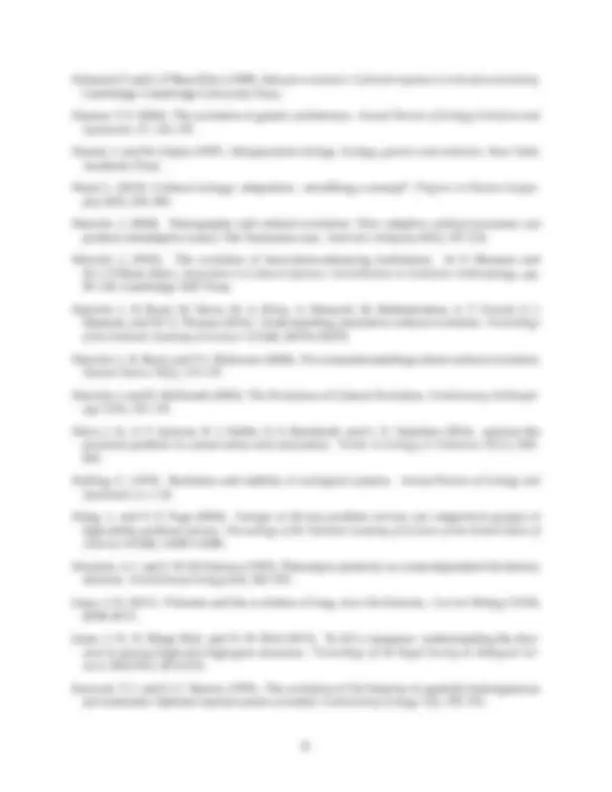
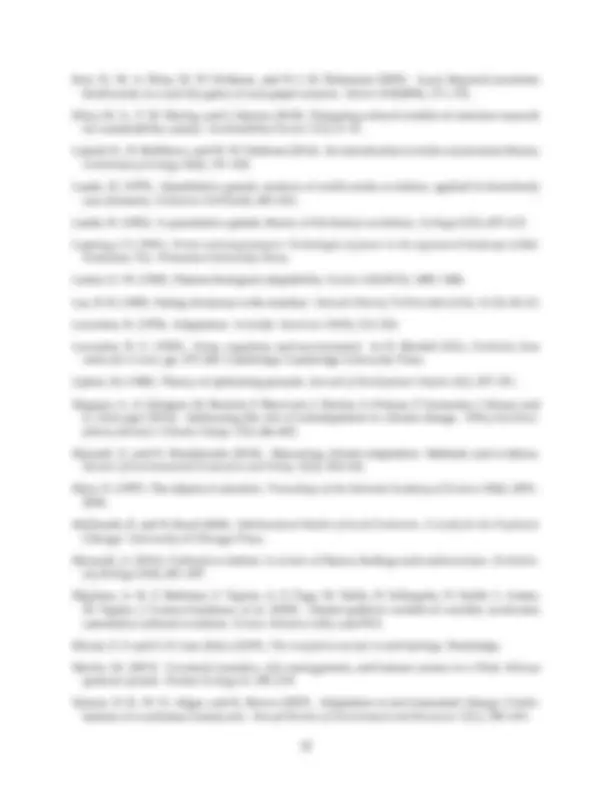
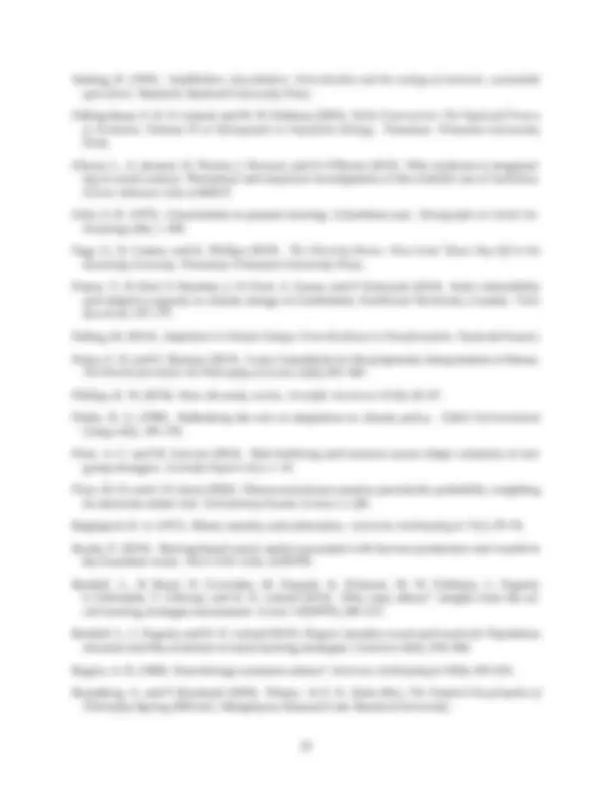
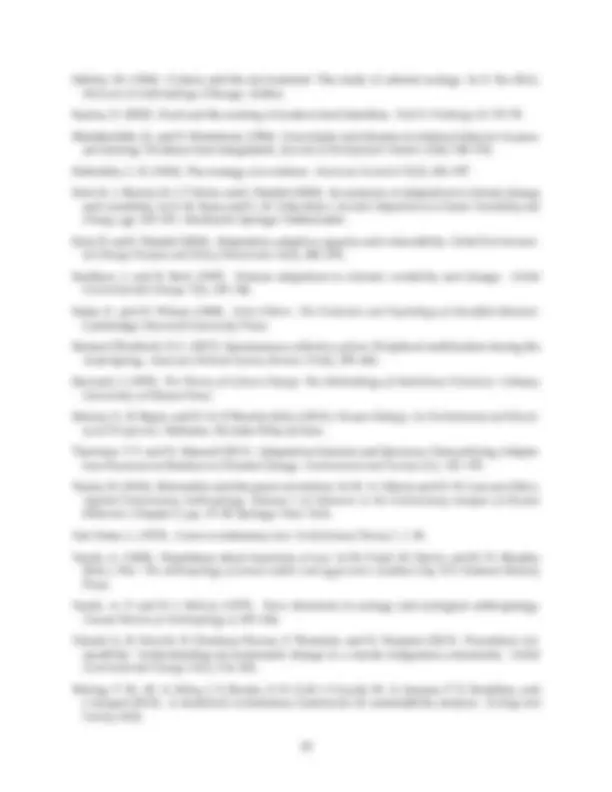



Study with the several resources on Docsity

Earn points by helping other students or get them with a premium plan


Prepare for your exams
Study with the several resources on Docsity

Earn points to download
Earn points by helping other students or get them with a premium plan
Community
Ask the community for help and clear up your study doubts
Discover the best universities in your country according to Docsity users
Free resources
Download our free guides on studying techniques, anxiety management strategies, and thesis advice from Docsity tutors
Originating in evolutionary biology, adaptation has been a central theme in biological anthropology and human ecology. More recently, the study of.
Typology: Summaries
1 / 25

This page cannot be seen from the preview
Don't miss anything!


















James Holland Jones Stanford University Elspeth Ready Max Planck Institute for Evolutionary Anthropology Anne C. Pisor Washington State University, Max Planck Institute for Evolutionary Anthropology
The idea of adaptation, in which an organism or population becomes better suited to its envi- ronment, is used in a variety of disciplines. Originating in evolutionary biology, adaptation has been a central theme in biological anthropology and human ecology. More recently, the study of adaptation in the context of climate change has become an important topic of research in the social sciences. While there are clearly commonalities in the different uses of the concept of adaptation in these fields, there are also substantial differences. We describe these differences and suggest that the study of climate-change adaptation could benefit from a re-integration with biological and evolutionary conceptions of human adaptation. This integration would allow us to employ the substantial theoretical tools of evolutionary biology and anthropology to understand what pro- motes or impedes adaptation. The evolutionary perspective on adaptation focuses on diversity because diversity drives adaptive evolution. Population structures are also critical in facilitating or preventing adaptation to local environmental conditions. This suggests that climate-change adaptation should focus on the sources of innovation and social structures that nurture innova- tions and allow them to spread. Truly innovative ideas are likely to arise on the periphery of cohesive social groups and spread inward. The evolutionary perspective also suggests that we pay careful attention to correlated traits which can distort adaptive trajectories, as well as to the importance of risk management in adaptations to variable or uncertain environments. Finally, we suggest that climate-change adaptation could benefit from a broader study of how local groups adapt to their dynamic environments, a process we call “autochthonous adaptation.”
Keywords: adaptation, climate change, anthropology, human biology
Introduction
Anthropology has a long tradition of studying adaptation. A first coherent program was laid out by Julian Steward and the subsequent development of cultural ecology endeavored to document and understand the varieties of human cultural adaptation to diverse ecologies and subsistence regimes (Steward, 1955). As interest in cultural ecology waned during the latter part of the twenti- eth century, the adaptation thread was picked up by more explicitly evolutionary scholars study- ing both the evolutionary ecology of humans embedded within ecosystems (Winterhalder, 1980) and the biological adaptations that enable culture (Henrich and McElreath, 2003). This increasing focus on adaptation in evolutionary anthropology happened in parallel with a growing interest in another process called ‘adaptation’ by other disciplines: the responses of human socio-ecological systems to the threats posed by climate change. While these uses of the term ‘adaptation’ are clearly related, there are also substantive differences between them. We will suggest that in order
∗James Holland Jones, Department of Earth System Science, Y2E2 Building, 473 Via Ortega, Room 140 Stanford, CA 94305-
to achieve the goals of climate-change adaptation—that is, to cultivate and support responses that help individuals and communities cope with the downsides of climate change—it is necessary to understand what ‘adaptation’ actually means (Thornton and Manasfi, 2011). Furthermore, we will argue that climate-change adaptation can be improved by taking an explicitly evolutionary perspective on the subject of adaptation. We will begin by defining how the concept of adaptation is used in evolutionary biology. We then move on to discussing the usage of adaptation in anthropology, noting a peculiar fixation with homeostasis that characterized thinking on adaptation during the heyday of cultural ecology in the mid-twentieth century. We then turn our attention to the resurgent interest in adaptation in the context of climate change. We will see that there are substantial ways that the many notions of adaptation in the climate-change literature differ from its canonical usage in evolutionary biology. The idea as used in the climate-change literature also retains an implicit focus on the maintenance of homeostasis, which is less emphasized in contemporary evolutionary theory. After reviewing the various perspectives on the study of adaptation, we will provide a brief overview of some relevant evolutionary theory. We will then suggest that adopting an evolu- tionary perspective on contemporary debates about adaptation focuses our attention on several important features. At its heart, evolutionary adaptation is a story of variance: the greater the vari- ance in a trait, the greater opportunity for adaptation and the faster adaptation will take place. For climate-change adaptation, this suggests that we should focus on the sources of innovation and risk (i.e., where variance in traits and in the environment come from), how linked traits can con- strain adaptive trajectories, and how population structure can facilitate the spread of innovations or provide risk buffering. We suggest that climate-change adaptation should be conceived more broadly, as a subset of more general adaptive processes. Thinking about climate-change adap- tation as an element of the human capacity to adapt then suggests that there is great utility in studying what we call autochthonous adaptations in local populations.
What Is Adaptation?
The notion of adaptation ultimately stems from biology. In explaining the diversity of life, Dar- win recognized that he had to explain not just how new species arose but why there are so many species in the first place. The theory that species are created by a process of descent-with- modification “even if well founded, would be unsatisfactory, until it could be shown how the innumerable species inhabiting this world have been modified, so as to acquire that perfection of structure and coadaptation which most justly excites our admiration” (Darwin, 1859, 3). The idea of adaptation is thus central to Darwin’s reasoning about the origin of species. In his classic essay, Lewontin (1978, 213) writes that adaptation “is the process of evolutionary change by which the organism provides a better and better ‘solution’ to the ‘problem’ and the end result is the state of being adapted.” Futuyma (2013, 296) adds a counterfactual element, defining an adaptation as “a characteristic that enhances the survival or reproduction of organisms that bear it, relative to alternative character states (especially the ancestral condition in the population in which the adaptation evolved).” Lasker suggests simply that “adaptation is the change by which organisms surmount the challenges to life” (Lasker, 1969, 1481). Most authors actually distinguish two forms of biological adaptation that differ in their char- acteristic time scale. The first is adaptation through natural selection or what is often called (es- pecially by social-science writers) “genetic adaptation.” Adaptation through natural selection is a process that typically requires many generations. The second notion of biological adaptation takes place on the scale of an individual organism’s lifespan and is typically referred to as “phys- iological adaptation,” “facultative adaptation,” or “plasticity.” Physiological adaptation involves
behavior, institutions, and social structures (Alland, 1975). Definitions of adaptation built around the maintenance of homeostasis dominated most work in anthropology in the middle and latter parts of the twentieth century. The homeostatic metaphor was extended from individuals to societies, as can be seen in the cybernetic approach of Gregory Bateson (summarized in his later work, Bateson, 1972) and carried on through the work of cultural ecologists such as Vayda, Netting, Rappaport, and others. Because the maintenance of home- ostasis requires feedback mechanisms, this work specifically emphasized adaptation in terms of feedback (Collins, 1965) that “[keeps] or [restores] some property or variable of a system within a certain range of states or values” (Vayda, 1968, 102). Perhaps the best-known of the cybernetic hu- man ecologists, Rappaport similarly defined adaptation as “the processes by which organisms or groups of organisms, through responsive changes in their own states, structures, or compositions, maintain homeostasis in and among themselves in the face of both short term environment fluctu- ations and long term changes in the composition or structure of their environments” (Rappaport, 1971, 60). Despite working at approximately the same time as the classic homeostatic cultural ecologists, Sahlins saw adaptation as “maximizing the social life chances” (Sahlins, 1964, 136). He also em- phasized that this maximization is done with respect to the constraints placed upon those adapting by not only the environment, but both “the internal structure of culture and the external pressure of environment.” Sahlins’s perspective echoed that of human biologist Morris Goodman, who noted that organic systems face constraints in two directions—that is, they must be internally and externally adapted (Goodman, 1963). Adaptations must obviously provide an advantage with re- spect to the external environment, but they must also be compatible with other elements of the organism’s phenotype. At a cultural level, this suggests that a solution to some external problem must also be compatible with the constellation of norms and practices that make up the culture. While working very much within the homeostatic tradition, Vayda and McCay (1975) pro- vided an important innovation for thinking about human adaptation. They were “particularly concerned with problems that carry the risk of morbidity or mortality, the risk of losing an ‘exis- tential game’ in which success consists simply in staying in the game” (1975, 293). In this way, they align with the notion of Slobodkin (1964) that the process of evolution can be viewed as an exis- tential game between the organism and nature. Vayda and McKay’s approach is also mirrored in the germinal work of Holling (1973), which has had a profound influence on the development of thought about climate-change adaptation. Consistent with Vayda and McKay’s focus on risk man- agement, we see adaptation as encompassing Holling’s original conception of resilience, which he motivated by suggesting persistence is a more salient outcome than equilibrium. This mode of thought on adaptation benefits “by viewing the behavior of ecological systems in terms of the probability of extinction of their elements, and by shifting emphasis from the equilibrium states to the conditions for persistence” (Holling, 1973, 2). We highlight Holling’s original meaning both because it has been so influential for subsequent work on climate-change adaptation, but also be- cause there has been considerable slippage in the implications of resilience. While Holling (1973) was explicitly trying to move away from homeostatic, equilibrium concepts, the idea of resilience has increasingly come to mean resistance to change (Olsson et al., 2015), a distinctly homeostatic notion. Risk management is particularly salient to understanding the human adaptive complex (Jones, 2011). Humans life histories are highly unusual and suggest that the management of risk must be an important component of their selective history. While variance in a trait at the population level may be good for adaptation, variance in fitness and its components is generally bad for individuals and lineages because of the multiplicative nature of fitness (e.g., Gillespie, 1974). Jones (2011) sug- gested that the extremely unusual combination of very late age at first reproduction and relatively
high fertility indicates that human life-histories are best interpreted as bet-hedging—adaptations that trade-off the mean to reduce variance. The avoidance of extinction through reproductive bet- hedging suggests that environmental variability and risk management have been fundamental elements of the human evolutionary experience (Pisor & Jones, this issue). As recently noted by Price and Jones (2020), many of the psychological quirks people show with regard to risk, un- certainty, and time preference may be attributable to selection on fitness-promoting behavior in highly variable environments. Here we suggest that any notion of adaptation is incomplete if it fails to consider the risk environmental and demographic variability pose for fitness. The dynamics of cultural systems are increasingly studied in the framework of cultural evo- lution, a rapidly growing field that sits at the intersection of evolutionary biology, anthropology, and psychology. Earliest formalization came from the work of Cavalli-Sforza and Feldman (e.g., Cavalli-Sforza and Feldman, 1973; Feldman and Cavalli-Sforza, 1975; Cavalli-Sforza and Feld- man, 1981) and Durham’s (e.g., Durham, 1979, 1992) gene-culture co-evolution theory. However, the early work that has had perhaps the most influence on the development of the field, largely as a result of the authors training the next generation of scholars, is that of Boyd and Richerson (1985). Importantly, their approach does not require any connection between cultural and genetic evolution. Cultural evolutionary studies generally focus on the different processes through which cultural traits can be transmitted and the consequences of these transmission processes for the dynamics of cultural systems, often with particular attention to the role of demography (Mesoudi, 2016; Derex and Mesoudi, 2020). In contrast to the classic evolutionary view of adaptation occurring through natural selection on genes, cultural evolutionary models often incorporate processes that at least implicitly allow for intent to become part of the process of adaptation. Models of “guided variation” assume that individuals choose which cultural traits to adopt based on their own experimentation or social learning about the payoffs of different traits (Boyd and Richerson, 1985). An important insight from this literature is that the dynamics of these systems are complex, and there are many factors that can limit the discovery or spread of adaptive cultural traits. Particularly important variables include the cost of individual versus social learning (Rogers, 1988), errors in the learning process (Henrich, 2004), and spatial or temporal heterogeneity in the environment (Derex and Boyd, 2016). Cultural evolutionary studies therefore allow us some insight into the conditions that can make it difficult for adaptive cultural traits to emerge and take root, even when agents have an ability to anticipate the consequences of their decisions. The state of being adapted, therefore, still emerges after the fact, as a consequence of population dynamics and selective processes.
Adaptation and Climate Change
While interest in studying adaptation faded from the research agendas of non-evolutionary an- thropologists toward the end of the 20th century, the idea was taken up with vigor over the past three decades by interdisciplinary scientists concerned with the negative effects of climate change on human livelihoods and well-being. Despite the long history of studies of adaptation within anthropology, this new notion of adaptation as climate-change adaptation has become dominant in literature on human-environment interactions. What do scholars concerned with the conse- quences of climate change for human populations mean when they use the term ‘adaptation’? How is this distinct from more conventional evolutionary and anthropological conceptions of the term? First, adaptation is typically contrasted with mitigation (Pelling, 2010). This contrast seems important for understanding the ways that climate-change adaptation differs in its usage from more traditional definitions of adaptation. Mitigation consists of actions meant to reduce or limit
with climate change), partly because too little is known about the properties of the socio-ecological systems on which interventions have been enacted. The centrality of feedback to adaptive processes creates a problem for the adaptation-mitigation binary, which Head (2010) notes is actually relatively new. As mitigation is an action taken by an individual (or collectively by a group of individuals) to improve their condition in the face of an environmental stressor, then mitigation would itself be considered adaptation in an evolutionary framework. More importantly, however, thinking about adaptation and mitigation as parts of a common process is consistent with recent thinking in evolutionary biology surrounding niche con- struction (Odling-Smee et al., 2003; Laland et al., 2016). As noted by Lewontin (1983), traditional views of adaptation see the organism as passively adapting to a largely autonomous environment. Lewontin suggested that, in fact, organisms take an active role in shaping their environments. This insight was then formalized into the framework we now recognize as niche construction (Odling- Smee et al., 2003). Humans are clearly modifying our environment (Field et al., 2012) and our actions to ameliorate any negative consequences to our livelihoods and welfare, whether these actions are considered adaptation or mitigation, will have consequences for the environment to which we will further need to respond. Finally, in the climate change literature the unit of analysis—what it is that actually “adapts”— is often taken to be the “socio-ecological system,” a vaguely-defined concept that is applied at multiple scales and using different ecological, political, or social and cultural criteria. A specific human settlement and its local resource catchment area are often taken as the specific object of study. However, decades of research in anthropology point out the dangers and difficulties of considering human settlements or groups at any scale as isolated systems whose members have convergent interests (Vayda and McCay, 1975; Moran and Lees, 2019). ‘Adaptations’ suggested in the climate change literature are often behaviors to be adopted by individuals, with limited con- sideration of collective action problems or barriers to uptake, such as different costs and benefits to people of varying socioeconomic status. In contrast, both evolutionary biology and evolution- ary anthropology primarily conceive of adaptation at the individual level, though they recognize there are specific conditions under which selection can act at the group level (Sober and Wilson, 1998; Boyd and Richerson, 2002). This is because natural selection will favor traits that improve the relative fitness of an individual within a population and not those that favor the survival of a group (Williams, 1966). The idea that individuals will adopt behaviors for the purpose of im- proving the resilience of the “socio-ecological system” or the “community” is therefore one that is potentially highly problematic from an evolutionary perspective and also potentially highly con- sequential to the effectiveness of interventions. In particular, the assumption that cultural prac- tices promote resilience because they are intended to “benefit the group” (itself a holdover from cybernetic cultural ecology) can mask inequalities that would likely constrain the resilience of the poorest members of the population (Moritz, 2013; Ready, 2018). While there are arguments for capitalizing on the structure of competing groups to achieve environmental ends (Waring et al., 2015), we think it is unlikely that the rather stringent conditions that favor group-level adaptation, in which the within-group costs are lowered relative to the between-group benefits (Zefferman, 2018), are likely to apply in most cases of contemporary climate-change adaptation. We can summarize what we see as the common differences between evolutionary adaptation and the development of the concept in the climate-change literature. These differences can be encapsulated by four contrasts:
change. In contrast, adaptation is generally seen as the positive result of a selective process in evolutionary approaches. We note that these positive/negative valences are distinct from how we might evaluate the consequences of an adaptation.
Are these differences between climate science and evolutionary science in how the concept of “adaptation” is used important? We argue that yes, they are. Given the confusion in how the term is used in climate science, and the urgency of the challenges posed by climate change, and the importance of predicting how communities may respond now and in the future to anthropogenic climate change, evolutionary theory can help us better establish how climate-change adaptation is most likely to work—and accordingly, how climate scientists, development partners, and poli- cymakers can foster adaptations that are locally appropriate and lasting.
Reuniting Evolutionary Theory and Climate-Change Adaptation
What does evolutionary theory have to offer climate-change adaptation? In this section, we will discuss (1) the central role of variance in traits for determining the rate of adaptation, and (2) the implications of indirect selection that can arise from selection on covarying traits. One fundamen- tal point that will emerge from this is the importance of generating diversity from which selective processes can then shape adaptations. This mandate for diversity leads us to think about the ori- gin and spread of innovations which, in turn, leads to another key point of evolutionary theory, namely, (3) how selection operates in heterogeneous populations. We further discuss these ideas in light of the apparent importance of risk-management in many aspects of human adaptation. From this review, we will summarize the lessons from evolutionary theory for climate-change adaptation. We emphasize that our focus is purely on “cultural” (i.e., non-genetic) adaptation; we think of traits here as being things like technologies, behaviors, beliefs, or institutions that have the potential to be transmitted via social learning. While they may be cultural, they are nonethe- less subject to evolutionary forces (Henrich et al., 2008). We should note, however, that the topics enumerated above have generally not yet been fully incorporated into the theory of cultural evolu-
frequent linkages (that is, covariance) between cultural elements and that, at intermediate levels of cultural linkage, the adaptiveness of cultural elements can be reduced. Diversity (or heterogeneity) is clearly fundamental for adaptation in biological systems. In social systems, its role in improving the performance of teams and institutions has received in- creasing attention (Hong and Page, 2004; Phillips, 2014; Page et al., 2019). As with biological adaptation, a diversity of ideas and potential solutions means that adaptive responses have more material on which to draw. However, perhaps equally important is the finding that diverse teams lead to the questioning of assumptions about how ideas naturally fit together (Phillips, 2014). The existence of diverse ideas in an organization, and the debate these ideas entail, can break strong covariances between ideas and foster adaptive solutions. While there is no obvious direct anal- ogy to this process in traditional quantitative genetics, it is reminiscent of the observation in the evolution-of-complexity literature that epistatic variance—the interactive, or multiplicative, rela- tionships between traits—can be converted to additive variance following population bottlenecks because the epistatic interactions become weakened through drift (Hansen, 2006). When these linkages are weakened (in other words, when the covariance between traits is reduced), selection can foster adaptation more quickly. We suggest that diversity in groups helps play the same role in cultural evolutionary processes. By challenging assumptions that might simply be accepted by more homogeneous groups, diverse social groups break up excessive covariance between traits that can impede movement toward adaptive attractors.
Selection in Heterogeneous Populations
Variance in traits is the key to adaptation, but that variance is reduced by the process of adap- tation itself as the adaptive solution comes to dominate the population. Population structure is essential for the maintenance of diversity. With what is perhaps surprising coherence, both evolutionary and social theory provide insights into how structure promotes diversity and what kinds of structures are most effective in doing so (Houston and McNamara, 1992; Kawecki and Stearns, 1993; Centola, 2018). A metapopulation is a population comprised of subpopulations connected through dispersal (Hanski and Gilpin, 1997). When some populations have positive (in- trinsic) growth rates and others have negative growth rates, the metapopulation is characterized by source-sink dynamics. Positive-growth subpopulations are sources, while negative-growth subpopulations are population sinks. Kawecki and Stearns (1993) noted that typically subpopu- lations become sinks because the organisms comprising them are not well-adapted to their local conditions, potentially because of local environmental change. Intuitively, we would imagine that the force of selection would be particularly strong on subpopulations that are not well adapted to local conditions. However, because of the connectivity among subpopulations, selection is en- trained to the mean of the overall metapopulation. This mean, in turn, will be dominated by the sources. The adaptation of the demographically dominant subpopulation inhibits the adaptation of the smaller subpopulations: the mean trait will reflect the conditions experienced by the source subpopulations, not the sinks. In short, strongly-connected metapopulations lead to the loss of adaptive local environmental tracking. This is also a problem noted by Whitehead and Richerson (2009) in the context of over-reliance on social learning. Connectivity hampers adaptive innova- tion through regression to the mean.
Conditions that Favor Innovation
The discussion of the last section showed that local adaptation can be inhibited by regression to the mean when metapopulations are strongly connected. A similar insight has been made in
Figure 1: Metapopulation with source-sink structure. Vertices (populations) are drawn in relative proportion to their size, while the arrows indicate the direction of dispersal and are proportional to its rate.
the study of innovation in both cultural evolution and sociology. Innovation is stifled by exces- sive connectivity, particularly to dominant cultural groups, and is cultivated by particular social structures that promote diversity. In this section, we discuss these social structures and relate the mechanisms by which they promote innovation back to the theory of selection in heterogeneous environments. Henrich (2010, 117) emphasizes population connectedness as a predicate for innovation: “a highly interconnected population can have high innovativeness even when it has relatively low inventiveness.” Thus, the degree of innovation in a population can be high, even if it is not creative, as long as it is strongly connected. While the dissemination of adaptive solutions to persistent problems certainly depends on the connectivity of a population, as with adaptation in metapopulations, the spread of innovations in social networks can actually be hampered by strong connectivity (Centola, 2018). The problem with connectedness is that it’s a two-way street. Yes, information about novel ideas can be disseminated as a result of connectedness. However, con- nectedness also leads to regression to the mean through peer pressure and social sanction. These are central ideas from Coleman’s (1988) conception of social capital as embodied in social closure. What matters more for innovation than uniform connectedness is heterogeneity. The development of innovation is fostered by heterogeneous structure. There needs to be some clustering of the network (implying cohesion) but clusters still need to be relatively distinct. As with the metapopulation model of Kawecki and Stearns (1993), too much connectivity between clusters swamps out local responsiveness. This is a fundamental point made in the cultural evo- lution literature by Derex and Boyd (2016) and Derex et al. (2018), who note that population frag- mentation maximizes cultural accumulation. Homogeneously-connected populations allow inno- vations to spread, but do not possess sufficient diversity to generate innovations. Local dispersal maintains clusters and thus maintains diversity, whereas long-distance dispersal reduces diversity by breaking up clusters (Kerr et al., 2002). These observations are consistent with the seemingly paradoxical finding that innovations spread from the less-connected periphery of populations to the core, rather than the other way around (Centola, 2019). Consider the densely-connected network in figure 2. While an innovation could spread rapidly to all parts of the graph if it were to appear in the light blue region (i.e., the core), the sort of so- cial sanction described by Coleman (1988) is likely to prevent such innovative ideas from taking hold in the first place: “Effective norms in an area can reduce innovativeness in an area, not only
and Richerson (2009) show how this phenomenon can lead to catastrophic consequences and em- phasize how promoting individual learning and innovation may be the only way to avoid such catastrophes. When represented as a cultural-transmission network, very strong social learning suggests a strongly-connected population and leads to the perverse selective dynamics described by Kawecki and Stearns (1993) and discussed above, while fostering individual learning generates structure. One mechanism to dampen this maladaptive effect is to ensure and maintain popula- tion substructure (Bunce and McElreath, 2018). Summarizing the innovations literature, once again, the key outcome that facilitates innovation is diversity. This time, however, the diversity is structural rather than phenotypic. Connectivity is important for dissemination of innovations, but as in the case of evolution in heterogeneous land- scapes, can impede responsiveness to local conditions. In the case of social networks, this results from innovations being squashed by regression to the mean, due to conformist bias and social sanction. As noted by Derex and Boyd (2016) and Derex et al. (2018), the optimal social structure for the spread of innovations will be characterized by intermediate connectivity. Moreover, in- novations are likely to flow from peripheral communities, where the social sanction of network closure is reduced (Coleman, 1988), into the core of larger groups (Centola, 2018, 2019).
Risk-reduction vs. Innovation?
In our earlier discussion of anthropological approaches to adaptation, we also described how human life histories, which are characterized by very late ages of first reproduction, relatively high fertility, and long reproductive spans, are quite unusual. Jones (2011) has suggested they can be understood as adaptations to highly-variable environments which can induce potentially large variance in fitness—meaning partly that these adaptations may be intended to buffer the risk of “zero fitness” (i.e., death/extinction). The definition of fitness is a difficult problem in the philosophy of biology (Rosenberg and Bouchard, 2020), but it is clear that a satisfactory measure of fitness should account for both differential increase (e.g., as given by the multiplicative rate of increase) and extinction risk (Pence and Ramsey, 2013). Risk management has also long played an important role in anthropological understandings of human behavior and culture, evolutionary and otherwise (e.g., Ortiz, 1973; Halstead and O’Shea, 1989; Cashdan, 1990), including in our own work on foraging strategies (Jones et al., 2013), exchange (Ready, 2018), and in- vs. out-group social ties (Pisor and Gurven, 2016). In an early piece on climate-change adaptation, Smithers and Smit (1997) draw a fundamental distinction between adaptations that buffer risk (and maintain the status quo) and adaptations that involve “evolution to a new state” (and are thus transformative). Again, however, we think this distinction is not productive. New strategies for buffering risk may be innovative and could be also transformative if, for instance, they lead to a redistribution of wealth within a population. An evolutionary perspective suggests that close attention should be paid to the relationship between risk-preferences, risk-buffering strategies, and innovation. In the previous section we discussed how innovation—the production of new cultural traits—is an underlying condition for new adaptations to emerge. But, colloquially, innovation is generally understood to be a risky (though potentially high reward) endeavor. Certainly, if the payoffs to adopting an innovation are themselves risky or uncertain (the latter meaning the payoff or its variance are unknown), then such innovations will be less likely to be adopted by risk-averse decision-makers. This problem has been much discussed in the anthropological and economic literature on peasant farmers (e.g., Lipton, 1968; Weeks, 1970; Shahabuddin and Mestelman, 1986), which warns us that we should carefully consider how the spread of innovations may interact with poverty and inequality. Human risk-buffering strategies are deeply social: they involve exchange of resources, in-
formation, assistance, and bodies over different spatial and temporal scales. Theoretically, one might expect that networks produced through the actions of individuals seeking to manage their exposure to risk would reflect the spatial and temporal scales of important sources of risk (Winter- halder, 1990). For instance, buffering of environmental risk on a relatively small-scale (e.g., day- to-day variance in hunting success) might be fostered by within-group sharing. Strong sharing norms enforced by social sanctions (as described among the !Kung by Lee (1969), for example) are common among historically-known hunter-gatherers. At the same time, Wiessner (1982) depicts long-distance long-term Hxaro exchange partnerships among the !Kung as a strategy for buffering larger, inter-annual kinds of risk such as droughts. This combination of dense local clusters with some connectivity between them sounds at least superficially like the structure we have described as fostering the dissemination of innovation (see also Migliano et al., 2020). Critically, however, it is important not to conflate function with design (Ensminger, 1994): though social practices and structures may have consequences, it does not mean that they evolved for that purpose. An im- portant and not yet fully answered set of research questions relevant for our understanding of human adaptation, both today and in the past, lie in better understanding the relationship be- tween population size and structure, different sources and scales of risk, and cultural innovation (Henrich et al., 2016; Fogarty and Creanza, 2017). For example, under what circumstances can risk-buffering strategies produce social structures that enhance innovation, and when might they inhibit them? How did different kinds of environmental risks and risk-management practices in- teract with innovation in the past, and how can this history help provide insight into adaptation to climate change today?
Autochthonous Adaptation
Above we have sketched the contours of an evolutionary approach to understanding how novel cultural adaptations emerge and spread. In this final section we propose the concept of au- tochthonous adaptation as a useful lens for identifying and studying this process empirically. Rather than contributing yet another entry to a typology of adaptation, our perspective focuses on the broader adaptability of people and on adaptation as a process rather than a specific outcome. The term “autonomous adaptation” is used for “automatic or in-built responses to climate change” (Carter, 1996, 30) as a contrast from more planned or prescriptive adaptations. We define autochthonous adaptation to retain the idea of a naturally-occurring response but also to empha- sizes that it comes from within the group undertaking the adaptation. Autochthonous adapta- tions are responsive to changing environments, arise from local processes and decision-making, and are dynamic, changing as the environment itself changes. Because autochthonous adapta- tion is rooted in a particular locality, it can lead to better tracking of the environment and greater ecological/energetic productivity (Lansing, 1991; Netting, 1993; Bird et al., 2012; Tucker, 2014). Autochthonous adaptations are a predicate for survival in many populations around the world today (Bird and Bird, this issue; Douglas & Rasolondrainy, this issue; Kramer & Hackman, this is- sue). The peripheral status of many of these populations with regard to larger, market-integrated societies also means they are likely to be sources of innovation. This suggests that protecting mi- nority cultures from being overwhelmed by dominant cultural groups is an important goal for maintaining adaptive potential (Bunce and McElreath, 2018). The study of autochthonous adaptation is what anthropologists have done historically (Ben- nett, 1976). Whether it is the ritual cycle of the Maring preventing land degradation (Rappaport, 1971), the subak system synchronizing irrigation schedules in Bali (Lansing, 1991), peasant farm- ers choosing the scale for cultivation that optimizes output (Netting, 1993), San hunter-gatherers managing shortfall risk through long-distance ritual sharing of hxaro (Wiessner, 1982), or Martu
Burton et al., 1993). Such reproduction allows for at least some of the trade-offs and unintended consequences to be played out so that a putative adaptation can be evaluated as to whether it is actually adaptive. We reiterate, however, that organisms and their environments are coevolving systems, as suggested by niche construction theory (Odling-Smee et al., 2003). Adaptation is a continuous process, and always relative to the other variants (e.g., ways of doing things) present in the population. Long live the Red Queen! The more dynamic evolutionary understanding of adaptation fundamentally emphasizes the need to pay attention to variance. In this paper, we have discussed three distinct ways that vari- ance matters for adaptation. First, variance (or diversity) in potential solutions to environmental problems represents the raw material from which selection shapes adaptation. Intuitively, the more possible solutions there are to choose from, the more likely that a better solution will be found. This suggests that we should think more about how to foster sources of variability for solutions to problems induced by climate change. Second, through analogy with the multivari- ate breeders’ equation and the developing theory of cultural epistasis (Brown and Feldman, 2009; Yeh et al., 2019), covariance between linked traits can inhibit the adaptive response of a multi-trait phenotype even to strong selection. Consistent with findings that diverse teams tend to question implicit cultural assumptions and produce more innovative solutions to problems (Phillips, 2014; Page et al., 2019), we have suggested that behavioral and cultural diversity may play an essential role in weakening unnecessary linkages between cultural traits that may inhibit movement to- ward adaptive solutions. This cultural process is reminiscent of the increase in additive variance following population bottlenecks (Hansen, 2006). Third, variance in social structure is essential for permitting local adaptation, for ensuring the spread of cultural innovations, and for increasing the net benefit of cumulative culture for the population more generally (Whitehead and Richerson, 2009; Derex and Boyd, 2016; Steinert-Threlkeld, 2017; Centola, 2019). These three roles for variance are all related to the processes through which adaptations are shaped. The fourth way that variance is essential for an evolutionary perspective on adaptation is for understanding the nature of adaptation itself and the willingness of individuals and com- munities to take up innovations that might prove adaptive. We have suggested that adaptation is ultimately a matter of management of environmental risk, a gambit to avoid Mayr’s “non-random elimination” (Mayr, 1997, Pisor & Jones, this issue). While variance at the population level in- creases the potential adaptive response of the population, variance at the individual level (e.g., in access to resources) can be catastrophic. Reducing variance by accepting a trade-off with the mean is the essence of risk management. The very networks through which innovations diffuse are also essential components of risk-management portfolios of people in subsistence populations. We need to be aware of the functionalist trap (Ensminger, 1994) of equating current utility for de- sign. While the social structures of subsistence populations may resemble the sorts of structures that promote the diffusion of innovations (e.g., Migliano et al., 2020; Derex and Boyd, 2016), this doesn’t mean that this structure was selected for this purpose. There are multiple potential forces shaping social structure and the transmission of cultural traits. Central among these are asymme- tries in population size or power across groups. In general, understanding the forces that shape the social structures, institutions, and behaviors we observe will aid us in predicting how these features will respond to changing environments. The world is complex and there are many possible solutions to problems presented by the en- vironment. Understanding the processes of culture change (e.g., where ideas/innovations come from, what their dynamics are once they enter a population) and selection, and having knowledge of what adaptations have emerged with respect to past problems (including social, political and economic aspects of environments), provides a powerful framework for evaluating the efficacy and viability of the planned “adaptations” policymakers wish to foster. This indicates an urgency
to the study of autochthonous adaptation in diverse settings: from remote subsistence groups to mega-cities, in the past and in the present. This includes the process of adapting to new pol- icy environments, such as carbon emission caps, and exploring how and why such policies may be unstable. Documenting and understanding these adaptations, especially understanding how the adaptations feed back on the environment and induce trade-offs, should be a foundational feature of any attempts by policymakers or development partners to manage the deleterious ef- fects of climate change. This perspective necessitates some humility on the part of planners and governments, as it acknowledges the fact that we still have much to learn about the dynamics of socio-ecological systems. Acknowledgements This paper has benefited from conversations and correspondence with Rebecca Bird, Ashley Hazel, Damon Centola, and Zack Almquist. Two anonymous reviewers provided valuable constructive feedback that improved the paper.
Cameron, E. S. (2012). Securing indigenous politics: A critique of the vulnerability and adaptation approach to the human dimensions of climate change in the Canadian Arctic. Global Environ- mental Change 22(1), 103–114.
Carter, T. R. (1996). Assessing climate change adaptations: The ipcc guidelines. In J. B. Smith, N. Bhatti, G. V. Menzhulin, R. Benioff, M. Campos, B. Jallow, F. Rijsberman, M. I. Budyko, and R. K. Dixon (Eds.), Adapting to Climate Change: An International Perspective, pp. 27–43. New York, NY: Springer New York.
Cashdan, E. (1990). Risk and uncertainty in tribal and peasant economies. Boulder, Colorado: West- view Press.
Cavalli-Sforza, L. and M. W. Feldman (1973). Models for cultural inheritance I. group mean and within group variation. Theoretical Population Biology 4(1), 42–55.
Cavalli-Sforza, L. L. and M. Feldman (1981). Cultural transmission and evolution: A quantitative approach, Volume 16 of Monographs in Population Biology. Princeton: Princeton University Press.
Centola, D. (2015). The social origins of networks and diffusion. American Journal of Sociol- ogy 120(5), 1295–1338.
Centola, D. (2018). How Behavior Spreads: The Science of Complex Contagions. Princeton: Princeton University Press.
Centola, D. (2019). The truth about behavioral change. MIT Sloan Management Review 60(2), 50–55.
Coleman, J. S. (1988). Social capital in the creation of human capital. American Journal of Sociol- ogy 94, S95–S120.
Collins, P. (1965). Functional analyses in the symposium ‘man, culture and animals’. In A. Leeds and A. Vayda (Eds.), Man, culture and animals, Volume 78 of Publications of the American Associa- tion for the Advancement of Science. Washington, DC: American Association for the Advancement of Science.
Darwin, C. (1859). The Origin of Species by Means of Natural Selection (1 ed.). London: John Murray.
Day, T. and R. Bonduriansky (2011). A unified approach to the evolutionary consequences of genetic and nongenetic inheritance. The American Naturalist 178(2), E18–E36.
Derex, M. and R. Boyd (2016). Partial connectivity increases cultural accumulation within groups. Proceedings of the National Academy of Sciences 113(11), 2982–2987.
Derex, M. and A. Mesoudi (2020). Cumulative cultural evolution within evolving population structures. Trends in Cognitive Sciences.
Derex, M., C. Perreault, and R. Boyd (2018). Divide and conquer: intermediate levels of population fragmentation maximize cultural accumulation. Philosophical Transactions of the Royal Society B: Biological Sciences 373(1743), 20170062.
Dodds, P. S. and D. J. Watts (2005). A generalized model of social and biological contagion. Journal of Theoretical Biology 232(4), 587–604.
Durham, W. (1979). Toward a coevolutionary theory of human biology and culture. In N. Chagnon and W. Irons (Eds.), Evolutionary biology and human social behavior, pp. 39–59. North Scituate, Massachusetts: Duxbury Press.
Durham, W. (1992). Coevolution: Genes, Culture, and Human Diversity. Stanford: Stanford University Press.
Egeland, G. M., L. Johnson-Down, Z. R. Cao, N. Sheikh, and H. Weiler (2011). Food insecurity and nutrition transition combine to affect nutrient intakes in Canadian Arctic communities. The Journal of Nutrition 141(9), 1746–1753.
Ensminger, J. (1994). The political economy of religion: An economic anthropologist’s perspec- tive. Journal of Institutional and Theoretical Economics (JITE) / Zeitschrift für die gesamte Staatswis- senschaft 150(4), 745–754.
Falconer, D. and T. Mackay (1996). Introduction to Quantitative Genetics. Essex, England: Pearson Education Limited.
Feldman, M. W. and L. L. Cavalli-Sforza (1975). Models for cultural inheritance: A general linear model. Annals of Human Biology 2(3), 215–226.
Field, C., V. Barros, T. Stocker, D. Qin, D. Dokken, K. Ebi, M. Mastrandrea, K. Mach, G.-K. Plattner, S. Allen, M. Tignor, and P. Midgley (2012). Managing the Risks of Extreme Events and Disasters to Advance Climate Change Adaptation: Special Report of the Intergovernmental Panel on Climate Change. Cambridge: Cambridge University Press.
Fisher, R. A. (1958). The genetical theory of natural selection (2nd ed.). New York: Dover.
Fogarty, L. and N. Creanza (2017). The niche construction of cultural complexity: interactions between innovations, population size and the environment. Philosophical Transactions of the Royal Society B: Biological Sciences 372(1735), 20160428.
Fogarty, L., N. Creanza, and M. W. Feldman (2015). Cultural evolutionary perspectives on creativ- ity and human innovation. Trends in Ecology & Evolution 30(12), 736–754.
Ford, J. D. (2008). Emerging trends in climate change policy: The role of adaptation. International Public Policy Review 3(2), 5–15.
Frank, S. A. (1997). The Price Equation, Fisher’s fundamental theorem, kin selection, and causal analysis. Evolution 51(6), 1712–1729.
Futuyma, D. (2013). Evolution (3rd ed.). Sunderland, MA: Sinauer Associates.
Gillespie, J. H. (1974). Natural selection for within-generation variance in offspring number. Ge- netics 76(3), 601–606.
Glantz, M. H. (1992). Global warming and environmental change in sub-Saharan Africa. Global Environmental Change 2(3), 183–204.
Goodman, M. (1963). Man’s place in the phylogeny of the primates as reflected in serum proteins. In S. Washburn (Ed.), Classification and Human Evolution, pp. 204–234. Chicago: Aldine.
Gore, A. (1993). Earth in the Balance: Ecology and the Human Spirit. A Plume book. Plume.